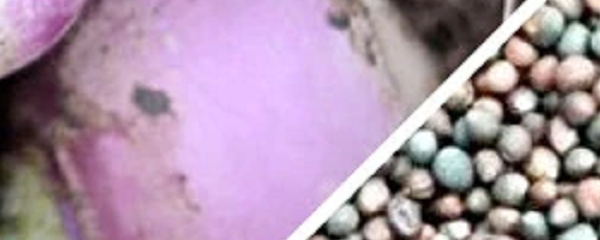

QUICK INFORMATION ABOUT TURNIPS
PROPER NAME
Brassica Rapa
COMMON NAME
Turnip
TYPE
Root Vegetable
HARDINESS ZONE
2 to 9 (Annual)
GERMINATION
7-14 Days
MATURE SIZE
30-45cm Tall / 15-25cm Wide
SUN EXPOSURE
Full Sun to Partial Shade
SOIL TYPE
Well-Drained & Sandy
SOIL PH
Acidic (6 to 6.5)
TURNIPS
The most familiar type of Turnip in Canada is the Purple and White Globe you typically find in your local grocer. However, a wide variety beyond these with different characteristics exist, such as root and leaf size, colour and flavour. Turnips are part of the Brassicaceae Family with edible greens on top that taste similar to Mustard Greens.
Turnips have leaves that are light green and are slightly hairy. They typically grow into an elongated oval with a wavy or toothed edge. With few exceptions, Turnips are usually white or yellow except for any part of the root exposed to the sun, which gets bleached purple or green. If you allow your Turnips to bolt, you will find small yellow flowers with four leaves in the shape of a cross. Hence you will sometimes hear it referred to as the “Cruciferous Vegetable.”
Ideally, you’ll be planting your Turnips in either the Early Spring or 70 days before the first frost in the Fall. Stagger planting will allow 2 to 4 crops a season if your growing zone allows, as they only require 1 – 2 months to mature.
PLANTING TURNIPS
DEPTH
1cm Deep
PLANT/ROW SPACING
10-15cm / 45-60cm
GERMINATION
7-14 Days
DAYS TO MATURITY
30-60 Days
PLANTING SEASON
Spring, Fall & Winter
Similar to Beets, Turnips are a very versatile crop. They are grown for their roots and greens. Capable of growing fairly quickly, most varieties mature within a couple of months, making it easy to collect multiple harvests per season. If you’re growing to obtain roots, they form best in the cooler temperatures around 15C, making Spring and Fall crops the favoured choice.
It is unlikely you will find transplants available in your local nursery as most people in our region plant via the Direct-Sow Method. Across Canada, we do this in the Early Spring or 70 days before your region’s first frost in the Fall.
Plant your seeds as soon as your soil is workable, approximately 1cm deep and every 4-6cm apart. Be sure to Successively Plant every 10-14 days for a prolonged harvest. Do this again 70 days before the first frost in your area to maximize productivity.
PRUNING TURNIPS
Once your seedlings have reached 7-10cm, be sure to Thin them out to about 10-15cm to provide optimal growing space. Use the small thinned leaves in a delicious fresh BEET GREEN SALAD.
Once your plants have reached between 15-25cm tall, use a sharp knife to cut the outside leaves off 1cm above the root, taking care not to damage the bulb. Doing this will stimulate new leaf production in the crown.
CARING FOR TURNIPS
LIGHT – Turnips will grow in partial or full sun but require a minimum of 4 – 6 hours of direct sunlight a day to thrive.
SOIL – You should amend your soil to be slightly acidic (6 – 6.5) for optimal growing conditions. Soil with plenty of Organic Matter and well-drained will help your Turnips grow and fend off Root Rot and other diseases.
WATER – Ideally, your Turnips will receive about 2.5cm of water each week for proper root development. Regular watering and excellent soil conditions are imperative for quick and healthy growth. If you find your Turnips are a bit more acrider than expected, you should try watering more frequently to get a better flavour.
TEMPERATURE/HUMIDITY – As stated above, Turnips prefer the cool of the Spring or Fall for optimal growing conditions.
FERTILIZER – Turnips are a very fast-growing plant. Always be sure to fertilize with rich, organic matter before sowing.
VARIETIES OF TURNIPS
ALLTOP
Alltop is usually grown for its greens. This cultivar only requires 35 days to fully mature, and if you don’t damage the crown of the root while harvesting, the leaves will resprout.
GOLDEN BALL
Golden Ball has a sweet, small yellow bulb with a hint of almond flavour. This cultivar requires around 60 days to fully mature.
PURPLE TOP WHITE GLOBE
Purple Top White Globe is the most popular cultivar in Canada. It’s the heartiest and easiest to grow in our climate, needing only 55 days to fully mature.
SCARLET QUEEN
Scarlet Queen is known for its scarlet exterior and white interior that is slow to turn pithy. This cultivar is an excellent option for storing over winter and takes a mere 45 days to fully mature.
SHOGOIN
Shogoin is typically grown for its large, flavourful leaves and has a delicious bulb. This cultivar takes approximately 45 days to reach full maturity.
TOKYO CROSS
Tokyo Cross is quick-growing, slow to turn pithy and very uniform in its growth. This cultivar matures quickly in only 35 days.
HARVSTING TURNIPS
You can harvest Turnips anytime after they reach 10cm tall. As long as you don’t harm the top of the root structure, the greens will regrow. The roots and greens are both best enjoyed when young and small. The bulb is best at 5-8cm in diameter and greens between 10-15cm. The older a Turnip gets, the higher the chances of it becoming bitter, tougher and pithier.
Fall Turnips should be left in the ground through the first frost to enhance the sweetness of the root. You can also harvest them well into the winter with proper Mulching to help prevent freezing and provide fresh Turnips past the growing season.
WINTERING TURNIPS
If you intend to store your Turnips, remove the leaves as soon as possible, as they will continue to leech energy and nutrients from the bulb. Use your greens as quickly as possible, as they will only keep in your refrigerator for between 3 and 7 days. The bulb can be stored in a root cellar or refrigerator for months as long as they stay cool and dry.
PESTS & DISEASES AFFECTING TURNIPS
Typical insect pests include Turnip Aphids and Flea Beetles, known for damaging your greens. The simple solution is to use row covers to keep them off your leaves. Root Maggots and Wireworms are much harder to deal with and damage your bulb.
Turnips are a member of the Brassica family. They are vulnerable to all the problems associated with it, including Anthracnose, Clubroot, Leaf Spot, Scab, Turnip Mosaic Virus, Rhizoctonia Rot, Root Rot and White Rust. The majority of these issues can be easily avoided by following the rule of not planting any Brassica family plant in the same spot for more than two years in a row. In the case of Clubroot, you should wait a minimum of six years to grow any Brassica family plant in that area.
Education, Tutorials, Planning & More…
Click Here to Return to the Main Page


